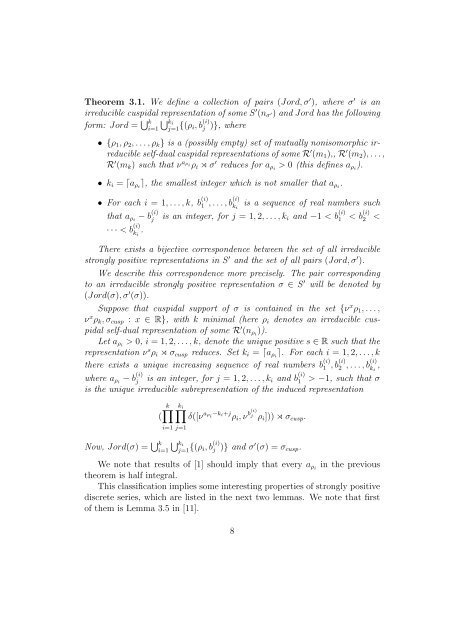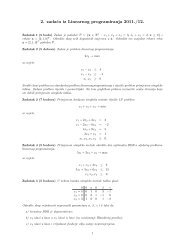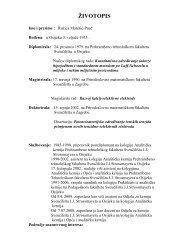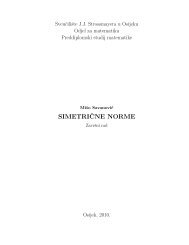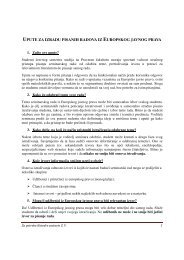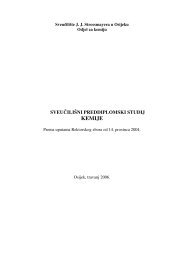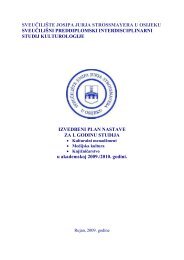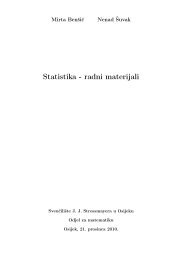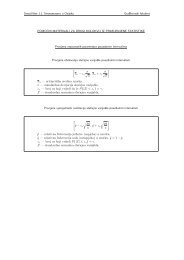Theorem 3.1. We define a collection <strong>of</strong> pairs (Jord, σ ′ ), where σ ′ is anirreducible cuspidal representation <strong>of</strong> some S ′ (n σ ′) and Jord has <strong>the</strong> followingform: Jord = ⋃ k ⋃ kii=1 j=1 {(ρ i, b (i)j )}, where• {ρ 1 , ρ 2 , . . . , ρ k } is a (possibly empty) set <strong>of</strong> mutually nonisomorphic irreducibleself-dual cuspidal representations <strong>of</strong> some R ′ (m 1 ),, R ′ (m 2 ), . . . ,R ′ (m k ) such that ν aρ iρ i ⋊ σ ′ reduces for a ρi > 0 (this defines a ρi ).• k i = ⌈a ρi ⌉, <strong>the</strong> smallest integer which is not smaller that a ρi .• For each i = 1, . . . , k, b (i)1 , . . . , b (i)k ithat a ρi − b (i)j· · · < b (i)k i.is a sequence <strong>of</strong> real numbers suchis an integer, for j = 1, 2, . . . , k i and −1 < b (i)1 < b (i)2 0, i = 1, 2, . . . , k, denote <strong>the</strong> unique <strong>positive</strong> s ∈ R such that <strong>the</strong>representation ν s ρ i ⋊ σ cusp reduces. Set k i = ⌈a ρi ⌉. For each i = 1, 2, . . . , k<strong>the</strong>re exists a unique increasing sequence <strong>of</strong> real numbers b (i)1 , b (i)2 , . . . , b (i)where a ρi − b (i)j is an integer, for j = 1, 2, . . . , k i and b (i)1 > −1, such that σis <strong>the</strong> unique irreducible subrepresentation <strong>of</strong> <strong>the</strong> induced representation(k∏ ∏k iδ([ν aρ i −ki+j ρ i , ν b(i) jρ i ])) ⋊ σ cusp .i=1 j=1Now, Jord(σ) = ⋃ k ⋃ kii=1 j=1 {(ρ i, b (i)j )} and σ′ (σ) = σ cusp .We note that results <strong>of</strong> [1] should imply that every a ρi in <strong>the</strong> previous<strong>the</strong>orem is half integral.This classification implies some interesting properties <strong>of</strong> <strong>strongly</strong> <strong>positive</strong><strong>discrete</strong> <strong>series</strong>, which are listed in <strong>the</strong> next two lemmas. We note that first<strong>of</strong> <strong>the</strong>m is Lemma 3.5 in [11].8k i,
Lemma 3.2. Let σ ∈ S ′ be a <strong>strongly</strong> <strong>positive</strong> <strong>discrete</strong> <strong>series</strong>. The σ isuniquely determined by [σ].Next result is ra<strong>the</strong>r straightforward from <strong>the</strong> mentioned classification:Lemma 3.3. Let σ ∈ S ′ denote a <strong>strongly</strong> <strong>positive</strong> <strong>discrete</strong> <strong>series</strong> and supposethat ν x ρ appears in [σ], where ρ ∈ R ′ is an irreducible unitarizable cuspidalrepresentation and |x| ≤ 1. Then <strong>the</strong> representation ν x ρ appears in [σ] withmultiplicity one. Also, if ν y ρ appears in [σ] for some y ≠ x, <strong>the</strong>n |y| > 1.Pro<strong>of</strong>. It is enough to prove <strong>the</strong> lemma for x ≥ 0, since o<strong>the</strong>rwise <strong>the</strong> sameconclusion can be drawn for |x|.We write σ as <strong>the</strong> unique irreducible subrepresentation <strong>of</strong> <strong>the</strong> induced representation<strong>of</strong> <strong>the</strong> form ( ∏ k ∏ kii=1 j=1 δ([νaρ i −ki+j ρ i , ν b(i) jρ i ]))⋊σ cusp . Obviously,ρ is isomorphic to ρ l for some l ∈ {1, 2, . . . , k}.By <strong>the</strong> assumption <strong>of</strong> lemma, <strong>the</strong>re is some j ∈ {1, 2, . . . , k l } such thata ρl −k l +j ≤ x ≤ b (l)j . Strong positivity <strong>of</strong> σ implies x > 0. Since a ρ l−k l +j >1 for j ≥ 2, it follows that ν x ρ appears in <strong>the</strong> segment [ν aρ l −kl+1 ρ l , ν b(l) 1 ρl ]and ν x ρ does not appear in [ν aρ l −kl+j ρ l , ν b(l) j ρl ], for j ≥ 2. Fur<strong>the</strong>r, usingx − 1 ≤ 0 we obtain x = a ρl − k l + 1.Consequently, ν x ρ appears in [σ] with multiplicity one.The inequality |y| > 1 for y ≠ x such that ν y ρ appears in [σ] is a consequence<strong>of</strong> <strong>the</strong> fact that |y| − x is a <strong>positive</strong> integer and x > 0.The principal significance <strong>of</strong> <strong>the</strong> following lemma is that it allows us toobtain certain embeddings <strong>of</strong> general <strong>discrete</strong> <strong>series</strong>.Lemma 3.4. Suppose that π ∈ S ′ (n) is an irreducible representation, whichis not in <strong>the</strong> <strong>discrete</strong> <strong>series</strong>. Then <strong>the</strong>re exists an embedding <strong>of</strong> <strong>the</strong> formπ ↩→ δ([ν a ρ, ν b ρ]) ⋊ π ′ ,where a + b ≤ 0, ρ ∈ R ′ and π ′ ∈ S ′ are irreducible representations.Pro<strong>of</strong>. We adopt <strong>the</strong> approach from <strong>the</strong> Section 3 <strong>of</strong> [10], which was motivatedby [16]. Suppose thatπ ↩→ ρ 1 × ρ 2 × · · · × ρ k ⋊ π cuspis an embedding <strong>of</strong> <strong>the</strong> representation π contradicting Casselman’s squareintegrabilitycriterium (whose metaplectic version is written in non-published9


